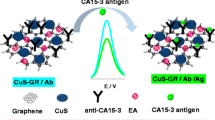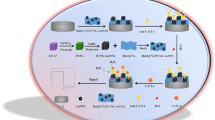Abstract
The present research was conducted to design and construct an electrochemical aptasensor for evaluating carbohydrate antigen 15-3 (CA15-3) as a biomarker for breast cancer. The aptasensor has been fabricated by a gold thin film (AuTF) electrodeposited on a cauliflower-like reduced graphene oxide-molybdenum sulfide nanocomposite (rGO-MoS2). The modified electrode’s surface was used to immobilize the thiolated aptamer, which was subsequently treated with CA 15-3 antigen. The aptasensor fabrication process was assessed using electrochemical impedance spectroscopy (EIS) and cyclic voltammetry (CV). This research also applied EIS to the quantitative measurement of CA 15-3 antigen by the proposed aptasensor. The interfacial charge transfer resistance (Rct) alteration before and after incubation of CA 15-3 by the immobilized aptamer was considered a signal for the quantitative measurement of CA 15-3. A linear concentration ranging from 5.0 to 200.0 U mL−1 with a detection limit of 3.0 × 10−1 U mL−1 was obtained for CA 15-3 using the EIS method. This designed aptasensor indicates satisfactory repeatability and stability, good selectivity, and high sensitivity. Moreover, clinical samples were assayed by the prepared aptasensor and compared with the ELISA method, yielding acceptable results. The recovery and relative standard deviation (RSD) of CA 15-3 in human serum samples were in the range 95.0 to 107.0% and 3.5 to 7.5%, respectively.
Graphical abstract







Similar content being viewed by others
References
Rao Bommi J et al (2023) Recent trends in biosensing and diagnostic methods for novel cancer biomarkers. Biosensors (Basel) 13(3):398. https://doi.org/10.3390/bios13030398
Sarhadi VK, Armengol G (2022) Molecular biomarkers in cancer. Biomolecules 12(8). https://doi.org/10.3390/biom12081021
Giaquinto AN et al (2022) Breast cancer statistics. CA Cancer J Clin 72(6):524–541. https://doi.org/10.3322/caac.21754
Azamjah N, Soltan-Zadeh Y, Zayeri F (2019) Global trend of breast cancer mortality rate: a 25-year study. Asian Pac J Cancer Prev 20(7):2015–2020. https://doi.org/10.31557/APJCP.2019.20.7.2015
Nguyen SM et al (2021) Delay in the diagnosis and treatment of breast cancer in Vietnam. Cancer Med 10(21):7683–7691. https://doi.org/10.1002/cam4.4244
Obeidy A et al (2022) Reliability of CA15-3 tumor marker in monitoring therapeutic response in different molecular subtypes of metastatic breast cancer. 31(6):899–902. https://doi.org/10.1016/0959-8049(94)00447-1
Mudduwa LKB, Peiris HH, Gunasekera SN, Abeysiriwardhana D, Liyanage N (2018) Elevated pre-surgical CA15-3: does it predict the short-term disease-free survival of breast cancer patients without distant metastasis? Int J Womens Health 10:329–335. https://doi.org/10.2147/ijwh.s162867
Jafari SH et al (2018) Breast cancer diagnosis: imaging techniques and biochemical markers. J Cell Physiol 233(7):5200–5213. https://doi.org/10.1002/jcp.26379
Lind K et al (2022) Routine X-ray of the chest is not justified in staging of patients with primary breast cancer. Dan Med J 69(11):A06220380
Corino GL et al (2009) Characterization of a test for invasive breast cancer using X-ray diffraction of hair-results of a clinical trial. Breast Cancer (Auckl) 3:83–90. https://doi.org/10.4137/BCBCR.S3596
Akbar Hasanzadeh HRA, Ebadati A, Nourizadeh H, Hashemzadeh I, Noori H, Seo S-W, Aref AR, Karimi M (2022) Recent progress of smart nano-based biosensors and their applications in biomedicine. World Sci Pub. https://doi.org/10.1142/S1793292022300067
Prante M et al (2020) Aptasensors for point-of-care detection of small molecules. Biosensors (Basel) 10(9):108. https://doi.org/10.3390/bios10090108
Strehlitz B, Nikolaus N, Stoltenburg R (2008) Protein detection with aptamer biosensors. Sensors (Basel) 8(7):4296–4307. https://doi.org/10.3390/s8074296
Bagheri Hashkavayi A, Raoof JB (2019) Ultrasensitive and reusable electrochemical aptasensor for detection of tryptophan using of [Fe(bpy)(3)](p-CH(3)C(6)H(4)SO(2))(2) as an electroactive indicator. J Pharm Biomed Anal 163:180–187. https://doi.org/10.1016/j.jpba.2018.10.006
Shahrokhian S, Ranjbar S (2018) Aptamer immobilization on amino-functionalized metal-organic frameworks: an ultrasensitive platform for the electrochemical diagnostic of Escherichia coli O157:H7. Analyst 143(13):3191–3201. https://doi.org/10.1039/C8AN00725J
Ranjbar SSAS (2019) Development of a sensitive diagnostic device based on zeolitic imidazolate frameworks-8 using ferrocene–graphene oxide as electroactive indicator for Pseudomonas aeruginosa detection. American Chemical Society. https://doi.org/10.1021/acssuschemeng.9b01314
Malekzad H et al (2017) Noble metal nanoparticles in biosensors: recent studies and applications. Nanotechnol Rev 6(3):301–329. https://doi.org/10.1515/ntrev-2016-0014
Sen RK et al (2022) 2D materials-based aptamer biosensors: present status and way forward. Curr Med Chem 29(37):5815–5849. https://doi.org/10.2174/0929867328666211213115723
Kim YJ, Jeong B (2018) Graphene-Based Nanomaterials and Their Applications in Biosensors. Adv Exp Med Biol 2018(1064):61–71. https://doi.org/10.1007/978-981-13-0445-3_4
Mondal A et al (2021) Boosting photocatalytic activity using reduced graphene oxide (RGO)/semiconductor nanocomposites: issues and future scope. ACS Omega 6(13):8734–8743. https://doi.org/10.1021/acsomega.0c06045
Ganatra R, Zhang Q (2014) Few-layer MoS2: a promising layered semiconductor. ACS Nano 8(5):4074–4099. https://doi.org/10.1021/nn405938z
Xiao Y, Liu Q, Huang Y, Tian F, Jia T, Zhang M, Liu Q, Wu J, Peng Y, Wang X (2022) Coordinative sulfur site over flower-structured MoS2 for efficient elemental mercury uptake from coal-fired flue gas. Chem Eng J 434. https://doi.org/10.1016/j.cej.2022.134649
Mehdizadeh A, Zeynali M, Karimi M (2020) Engineering of MoS2 nanoribbons as high-performance materials for biosensing applications. Appl Surf Sci 540. https://doi.org/10.1016/j.apsusc.2020.148349
Topçu E, Dağcı Kıranşan K (2019) Flexible gold nanoparticles/rGO and thin film/rGO papers: novel electrocatalysts for hydrogen evolution reaction. J Chem Technol Biotechnol:3895–3904. https://doi.org/10.1002/jctb.6187
Ferreira CS, Matthews CS, Missailidis S (2006) DNA aptamers that bind to MUC1 tumour marker: design and characterization of MUC1-binding single-stranded DNA aptamers. Tumour Biol 27(6):289–301. https://doi.org/10.1159/000096085
Santini BL et al (2020) In silico design of novel mutant anti-MUC1 aptamers for targeted cancer therapy. J Chem Inf Model 60(2):786–793. https://doi.org/10.1021/acs.jcim.9b00756
Yu H et al (2016) High-efficient synthesis of graphene oxide based on improved Hummers method. Sic Rep 6:36143. https://doi.org/10.1038/srep36143
Jaswal A et al (2021) Adsorptive removal of antibiotic ofloxacin in aqueous phase using rGO-MoS(2) heterostructure. J Hazard Mater 417:125982. https://doi.org/10.1016/j.jhazmat.2021.125982
Chen Z et al (2023) Two-channel electrochemical immunosensor based on one-step-synthesized AuPt-boron-doped graphene electrode for CA153 detection. Biosens Bioelectron 222:114974. https://doi.org/10.1016/j.bios.2022.114974
Patil SM, Karade VC, Kim JH, Chougale AD, Patil PB (2022) Electrochemical immunosensor to detect breast cancer marker CA 15-3 antibody. Mater Today Commun. https://doi.org/10.1016/j.mtcomm.2022.104856
Mandal M et al (2014) High performance supercapacitor electrode material based on flower like MoS2/reduced graphene oxide nanocomposite. International Journal of Latest Research in Science and Technology. https://doi.org/10.29111/ijlrst
Zou L, Qu R, Gao H, Guan X, Qi X, Liu C, Zhang Z, Lei X (2019) MoS2/RGO hybrids prepared by a hydrothermal route as a highly efficient catalytic for sonocatalytic degradation of methylene blue. Results Phys 2019. https://doi.org/10.1016/j.rinp.2019.102458
Asadzadeh-Firouzabadi A, Zare HR (2017) Application of cysteamine-capped gold nanoparticles for early detection of lung cancer-specific miRNA (miR-25) in human blood plasma. Anal Methods. https://doi.org/10.1039/C7AY01098B
Ranjbar S, Astani NA, Atabay M, Naseri N, Esfandiar A, Ejtehadi MR (2022) Electrochemical and computational studies of bio-mimicked Ti3C2Tx MXene-based sensor with multivalent interface. J Colloid Interface Sci:1063–1074. https://doi.org/10.1016/j.jcis.2022.05.033
Marques RC, Costa-Rama E, Viswanathan S, Nouws HP, Costa-Garcia A, Delerue-Matos C, González-García MB (2018) Voltammetric immunosensor for the simultaneous analysis of the breast cancer biomarkers CA 15-3 and HER2-ECD. Sensor Actuat. B-Chem:918–925. https://doi.org/10.1016/j.snb.2017.08.107
Shekari Z, Zare HR, Falahati A (2021, 2021) Dual assaying of breast cancer biomarkers by using a sandwich–type electrochemical aptasensor based on a gold nanoparticles–3D graphene hydrogel nanocomposite and redox probes labeled aptamers. Sens Actuators B: Chem. https://doi.org/10.1016/j.snb.2021.129515
Acknowledgements
It is important to appreciate the Iran University of Medical Science for sponsoring this project (Grant No. 99-2-14-18485). Also, the authors of this article are grateful to the head of Sharif University of Technology Biomaterials Engineering Laboratory (Faculty of Science and Materials) and laboratory (Faculty of Physics). Additionally, it is mentioned N Naseri was supported from the Research and Technology Council of the Sharif University of Technology (Grant No. G4000212).
Author information
Authors and Affiliations
Corresponding author
Ethics declarations
Conflict of interest
The authors declare no competing interests.
Additional information
Publisher’s Note
Springer Nature remains neutral with regard to jurisdictional claims in published maps and institutional affiliations.
Rights and permissions
Springer Nature or its licensor (e.g. a society or other partner) holds exclusive rights to this article under a publishing agreement with the author(s) or other rightsholder(s); author self-archiving of the accepted manuscript version of this article is solely governed by the terms of such publishing agreement and applicable law.
About this article
Cite this article
Vojgani, Y., Ranjbar, S., Naseri, N. et al. Quantitative measurement of CA 15-3 cancer biomarker using an electrochemical aptasensor based on the electrodeposition of Au thin film on cauliflower-like rGO-MoS2 nanocomposite. Microchim Acta 190, 406 (2023). https://doi.org/10.1007/s00604-023-05989-4
Received:
Accepted:
Published:
DOI: https://doi.org/10.1007/s00604-023-05989-4




